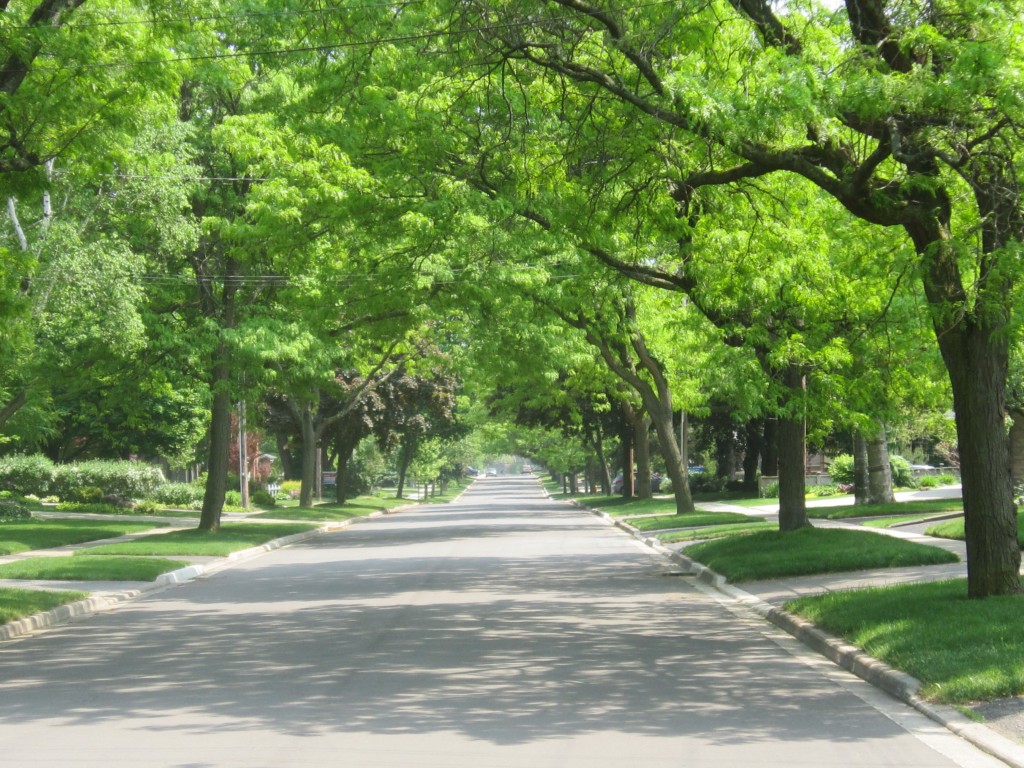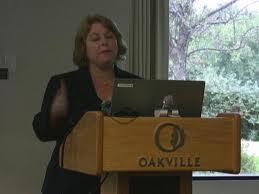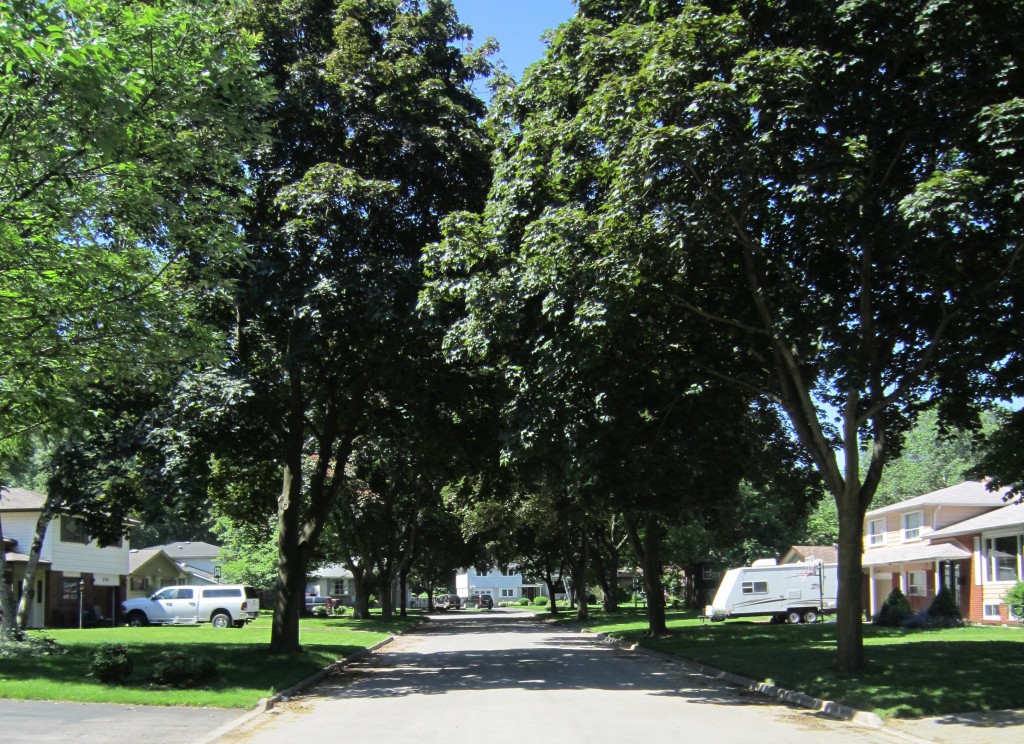BURLINGTON, ON. July 10, 2013. When asked how he felt things were going at a meeting of residents at LaSalle Pavilion who were talking about a Private Tree bylaw Mayor Rick Goldring said he didn’t feel he could go wrong; “half the people want one the other half don’t”.

People pay a premium to live on streets like this. while most of these trees are on city property there are hundreds in back yards that are private. They add to the value of the property, the health of the community and the sheer enjoyment of live.
The Council he leads didn’t see it that way and voted 5-2 to receive and file a lengthy report on what people thought about a Private Tree bylaw. City hall staff recommended doing nothing –other than educating the public. This Council had no appetite for taking on a problem that is out there – a private tree bylaw is not popular because of ignorance and misunderstanding.

While Liz Benneian made a number of strong points during her delegation to Burlington`s city council – she could not convince them to work towards creating a Private Tree bylaw.
Liz Benneian, former president of Oakvillegreen Conservation Association and the person that led that organization during the time it was advocating for the creation of a private tree bylaw in Oakville.
She was delegating to Council to talk about the Oakville experience.
“The Urban Forest” she said “faces many challenges including poor quality compacted soil; salt exposure; little natural regeneration; invasive species and pests and development.
“If we want to have a healthy urban forest and reap all the benefits that trees provide including increased property values and improved air quality, then local Councils must enact a suite of measures to protect and plant trees.”
Benneian explained that in Oakville developers would buy land and clear the lot first and then submit a site plan. It’s at the site plan stage where municipal staff has some input on what trees must be preserved. But by the time the plans went to site plan, there were no trees left on the lot.
“So this is the critical issue, that I don’t believe it has been made clear during your public consultation to date: developers, who own property, and homeowners are exactly the same under the law. There is no distinction; both are private property owners. And if there is no Private Tree Bylaw, then developers can clear all the trees off a property if they like.”
“But if there is a private tree bylaw then developers can no longer buy up land, strip it of trees and then take a site plan to a planning department.”
 Trees are a community asset maintained Benneian, and their loss affects the quality of life of the neighbourhood. And that for at least half of Burlington is the rub- far too many people have yet to buy into the argument that trees are communal. We still have people who feel that the tree is on their property and they can do whatever they want whenever they want.
Trees are a community asset maintained Benneian, and their loss affects the quality of life of the neighbourhood. And that for at least half of Burlington is the rub- far too many people have yet to buy into the argument that trees are communal. We still have people who feel that the tree is on their property and they can do whatever they want whenever they want.
“Getting a tree bylaw passed was not easy in Oakville” explained Benneian. “A small but very vocal property rights group sprang up. Their fundamental argument was that no one should have the right to tell them what they could and couldn’t do on their property. That argument is quite ridiculous. We have many laws that restrict what property owners can and can’t do: For instance, I can’t decide to have a bonfire in my backyard, I can’t dump hazardous waste on my land and I can’t tear down my old garage and rebuild it without a permit. But despite their weak argument they raised a lot of noise at the time and spread a lot of misinformation,” said Benneian.
Many of the people who spoke at Oakville’s Council said things like “we agree developers should be controlled but leave us alone” – clearly not understanding the fundamental problem that developers and private property owners were the same under the law.
Oakville looked for a way to find common ground. They formed a committee that included the most vocal anti-tree bylaw. Oakville’s Council considered the suggestions made by that committee and enacted a compromise bylaw, which Council has amended once to make it stronger and will be amending it again soon.
Benneian pointed out that vocal property rights group has simply faded away. “When the first set of amendments were made not a peep was heard from them.”
“While homeowners may cut down a tree here and there to put in a pool or expand a driveway, their impact on the urban canopy is minimal. As your surveys suggest, individual homeowners are not a significant problem in tree loss. But developers are. So the trick is creating a Private Tree Bylaw that won’t unduly infringe on homeowners while it will stop developers from clear-cutting.”
Benneian added that “just because it’s tricky, doesn’t mean it can’t be done. Your telephone survey demonstrates that your citizens understood that – 90% suggesting various exceptions to the bylaw that would allow for tree removal in certain cases. It’s important to note that only 10% of respondents said they would not be in favour of a private tree bylaw despite exemptions.
Burlington is in much the same situation as Oakville, all the big Greenfield developments are complete or fully planned. Now that we are at build out, development will come through infill and this is where the challenge to protect our urban tree canopy in our most established and beautiful areas becomes critical. These are also the areas with the largest and oldest trees that are providing the most community benefits. Their loss will be greatly felt by your entire community.
After all the public consultation, City of Burlington staff are not recommending a private tree bylaw at this time. Instead, the focus of staff efforts should be on public education and awareness.
This was hard for Benneian to understand as Burlington’s current and future tree loss (aside from the ravages of Emerald Ash Borer) will mostly be due to infill development. She explained that when you are trying to deal with a problem, you must choose the right tool set.”
To chuckles throughout the Council chamber Benneian declared: “Developers are immune to “education and awareness”. The best, and I would add the ONLY effective tool to prevent clear-cutting by developers, is a bylaw.”
Benneian used the survey the city had done and pointed out that a majority of Burlington’s citizens clearly place City Council as the agency responsible for protecting the community’s trees. In fact, in that survey, more residents choose “Pass Bylaws to protect trees” than any other response at 22%. “Maintain and protect trees” followed at 21% and “Oversee development to ensure trees are protected” came in third at 20%. If you add in “Enforce bylaws/issue fines” (8%), “protect older mature trees” (4%), “Prevent clear-cutting (3%), “Require a permit for tree cutting (3%); “Slow/halt development” (2%) then 83% of respondents were clear that development was the problem and a bylaw/permit system was needed.
“Public awareness and education is all well and good, but it will not stop developers from cutting down trees and it will only have limited success with homeowners”, said Benneian.
Burlington has decided to go the “education and awareness route. Benneian pointed out just how ineffective this approach has been in the past. “Despite a decade of education on the life-saving benefits of wearing seatbelts it wasn’t until legislation was introduced in 1989 that seatbelt use climbed in the U.S. from 21% to 70%.”

If these were all private trees and they were all cut down – it would certainly be a different looking place to live – and the value of the houses would plummet.
“Results of your own online survey” Benneian pointed out, “suggest that education alone isn’t effective at impacting people’s tree-related behaviour. In your online survey you asked people who had ash trees on their property if they had treated them for emerald ash borer, and despite all the publicity to date, 76% said no.
The one outstanding feature of the information gathered during your public consultation”, explained Benneian, “is the citizens of Burlington, like the citizens of Oakville, appreciate the value of their urban forest.”
The task now is to find a way to get this issue back on the agenda in Burlington. That 5-2 vote to receive and file meant it is off the table.




















In Oakville, at election time, the community showed it’s displeasure by changing it’s Council members to those who
are more environmentally sympathetic. Burlingtongreen could help towards this same end by reporting on how individual members vote on any such issues, including the tree bylaw.
from now on.
If the trees come down faster than they are replaced, how will we increase our tree coverage, the lungs of our planet (oxygen)? And they absorb carbon dioxide, a gas which is bringing about global warming. The developers don’t care about trees, only profits. Prior to the mid-80’s Headon Forest was a forest…now it’s all developed. The same is true for the Orchards. As the older parts of Burlington are re-developed, the large mature trees will fall, to be replaced by a twig in the front yard. Thus far, ecologically responsible development is but a dream of too few. Some day our society will wake up to realize that the dream was really a night mare, with consequences.